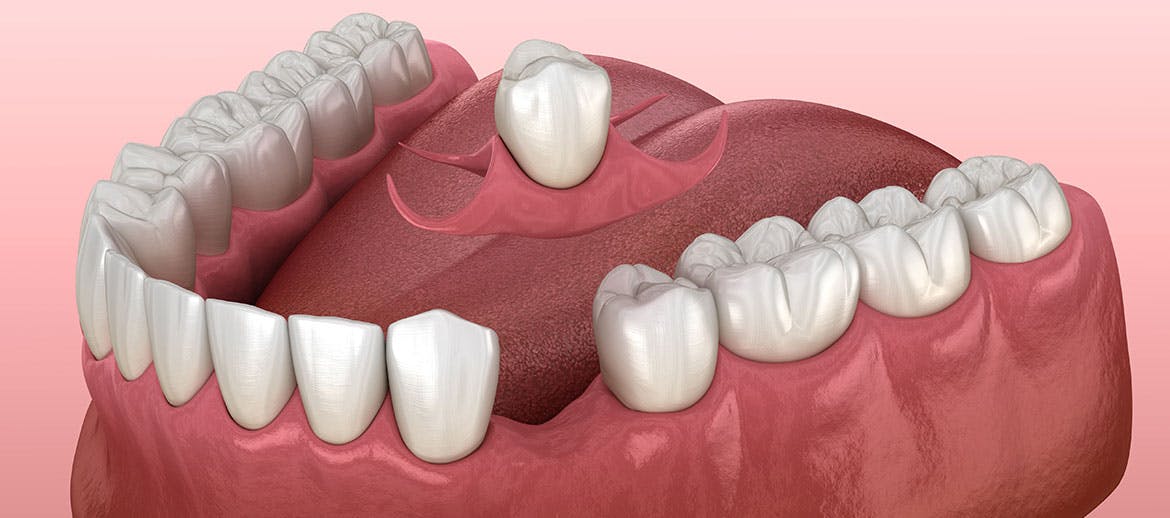Single Tooth Denture Options
Modern dental innovations have created a variety of replacement options for patients who are missing one or more teeth. If you’re missing a tooth, you aren’t alone. According to the American College of Prosthodontists, more than 36 million Americans do not have any teeth and 120 million people are missing at least one tooth in the U.S. Over the next 20 years, experts predict both of these numbers will continue to rise.1
If you’ve lost a tooth recently, you’re probably researching for the best replacement options. There are numerous options for replacing missing teeth, such as dental implants, dental flippers, partial dentures, and fixed bridges. Consulting with your dentist is necessary to assure the replacement is appropriate for your need.
Missing Teeth Solutions
You have options for replacing missing teeth that each have unique benefits. Consult with your dentist about these replacement options.
Removable Partial Dentures
Removable partial dentures can be made to replace multiple missing teeth. Partial dentures have replacement teeth attached to a gum-colored base that blends in with the rest of your mouth.2 One type features a clasp used to attach the denture to the rest of your teeth, and, depending on how it’s made, could feature a metal frame under its acrylic base. Removable partial dentures are used to restore a patient’s smile and improve their ability to eat and speak.2
Fixed Bridges
Fixed bridges are a more permanent solution to missing teeth. Fixed bridges fill a space where one or more teeth are missing, using a cement that only your dentist can remove. They are usually made using a combination of metal, ceramics, or glass. Since your dentist will need to prepare the two teeth on either side of your gap before attaching a bridge, it might take multiple visits to finalize this procedure. Your dentist will also need to take an imprint of the gap in your teeth to send to the lab so they can custom make your bridge.3
Dental Implants
Dental implants are long-lasting replacements for missing teeth that function as the anchor for one or more prosthetic teeth. Dental implants are made of a titanium post that’s surgically inserted into the upper or lower jaw where you would find the tooth’s root, followed by a crown or denture that’s attached to the implant to look like a natural tooth. Today’s implants are predominantly made of titanium, a metal that is bio-compatible and offers strength and durability. Dental implants can also be used to support removable or fixed dentures to keep them securely in place.2,3
Why Do We Lose Our Teeth?
Tooth loss can result from a number of issues, such as poor oral hygiene that leads to gum disease or an accident or injury that causes trauma to the tooth. Luckily, some of these common causes of tooth loss can sometimes be prevented.
Age and Tooth Loss
As people age, their teeth and gums can wear down or become more susceptible to infection. A lifetime’s worth of chewing and crunching can wear down your molars. Furthermore, repeated exposure to acidic foods can weaken your protective enamel, which can lead to more serious dental problems like tooth loss.
Periodontitis
Periodontitis remains one of the leading causes of tooth loss. Periodontitis is a severe form of gum disease that starts as a milder form of gum disease called gingivitis. In severe cases, the buildup of bacteria and plaque, which hardens into tartar, can build up below the gum line and lead to the loss of bone. This could cause loosening of the teeth, which could lead to tooth loss. Periodontitis is very common: It affects 70% of adults ages 65 and older and 47% of adults ages 30 and over.4
Tooth Decay and Cavities
Tooth decay and cavities are another leading cause of tooth loss. Cavities are permanently damaged areas in the outer surface of your tooth that develop into tiny openings or holes. Cavities can be caused by a multitude of factors including a buildup of bacteria in your mouth, drinking sugary drinks, or poor dental hygiene.5
How to Prevent Tooth Loss
Periodontitis and tooth decay are largely preventable with a good dental hygiene routine. Brushing and flossing daily and regularly scheduled dentist appointments (every 6 to 12 months, or what is recommended by your dental professional) reduces your chances of developing periodontitis and protects against tooth decay.5
Source Citations:
- Facts & Figures. https://www.gotoapro.org/facts-figures/. Accessed 12/16/21.
- Tooth Replacement Options. ADA Patient Smart. http://www.ada.org/~/media/ADA/Publications/Files/ADA_PatientSmart_Tooth_Replacement.ashx. Accessed 9/1/21.
- Guide to Dental Implants: A Popular Option for Tooth Replacement | College of Dentistry. University of Illinois Chicago. https://dentistry.uic.edu/patients/dental-services/general-family-dentistry/guide-to-dental-implants-a-popular-option-for-tooth-replacement/. Accessed 9/1/21.
- Periodontitis - Symptoms and causes. Mayo Clinic. https://www.mayoclinic.org/diseases-conditions/periodontitis/symptoms-causes/syc-20354473. Accessed 9/1/21.
- Cavities/tooth decay - Symptoms and causes. Mayo Clinic. https://www.mayoclinic.org/diseases-conditions/cavities/symptoms-causes/syc-20352892. Accessed 9/1/21.





